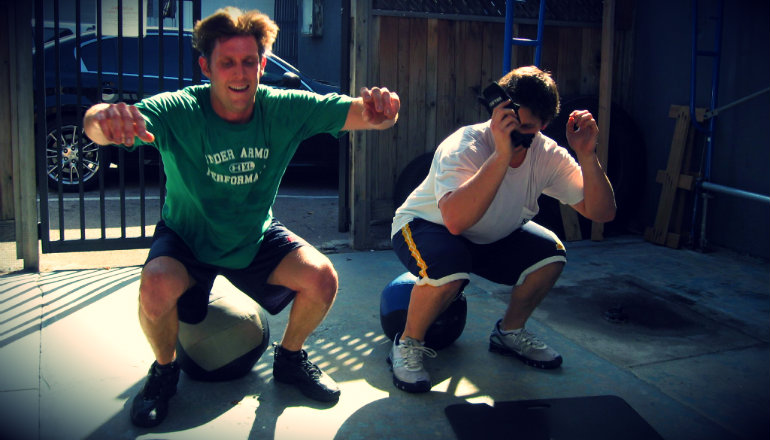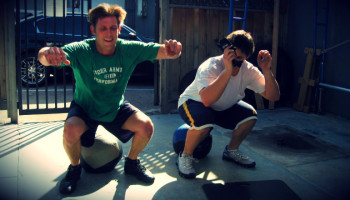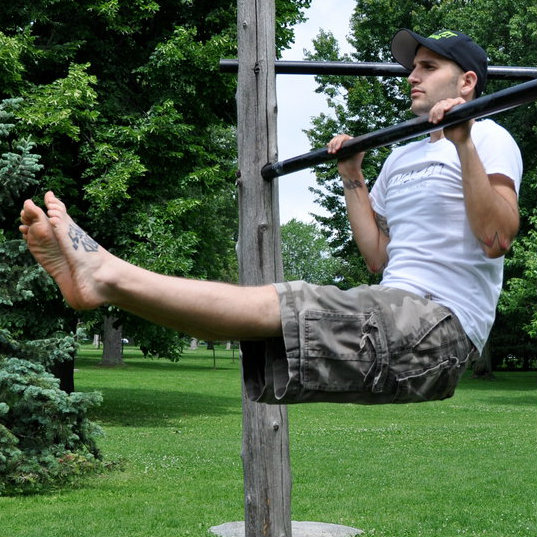 Reading Time: 5 minutes
Reading Time: 5 minutesThe bodyweight squat is an essential movement that you’re most likely using daily. The natural primal resting position is the deep squat. You squat to pick up objects or to inspect something on the ground. You even squat to sit up from or down on the couch.
The question is, are you squatting correctly and what issues are keeping you from performing a clean squat? A clean squat can spare your knees, hips, and back from injury, as well as improve your quality of life and overall life expectancy. The deep squat is a fantastic exercise for general fitness, and it also develops the hip mobility and strength to go from a seated position to standing. If you want to retain your independence and health, the last thing you want is to find yourself unable to get up from the ground as you grow older.
Today we’re going to explore four common issues you might be facing and then show you how to fix your squat. Watch the video, then read the details below.
Problem: Your Knees Cave Inward When You Stand
Solution: Band Your Knees
I see this all the time, not just with new trainees but also with seasoned athletes. Not only does it look ugly, but your knees caving inward while you stand out of your squat points to a lack of glute activation. This can lead to knee injuries, hip pain, and knee pain. (Click here to read more about how to fix your glutes.)
By simply taking a resistance band and looping it around both legs, just below the knees, you can easily remedy this issue. In fact, many people find their hip or knee pain disappears completely when performing this simple technique. By using the resistance band you’ll be forcing yourself to fight against its inward pressure. This will activate your glutes more effectively and force you to spread the knees apart during the squat.
Start with a lighter band and work up to a heavier band as you become more efficient. Eventually you’ll no longer need the band around the knees in order to perform your squats. But that doesn’t mean you have to get rid of it completely! It’s always a great way to warm up the glutes before training or to throw in once in a while to spice things up.
Problem: You Lift Your Heels or Can’t Squat Deeply
Solution: Put a Wedge Under Your Heels
During your squat, the majority of your weight should placed in the heel of each foot. There should be some pressure through the ball of the foot, but if your heels are lifting off the floor, then you’ve got a problem. Yes, there are squat variations where you go up onto the toes. Yes, they can be safe. And, yes, I do coach them from time to time. However, those are more advanced versions of the squat and they’re not suitable for someone who is not yet able to perform a basic squat correctly.
Not being able to sit on your heels during your squat can be caused by a number of things such as fear of falling, quad dominance, or a lack of mobility. Regardless of the issue, placing a wedge under each heel helps instantly.
Set up as you would for a regular squat, then place an object such as a thin board, thin weight plate, or small stone under the back of each heel. You can get creative with the object you use, I’ve even used sticks and tree branches. By doing this, you’ll be elevating your heels, allowing you to really dig them into the object and get a feel for sitting on your heels. This also works wonders for those who have trouble getting into a deep squat. Most people find they can squat much deeper this way.
Over time, you’ll become more comfortable sitting on your heels during the squat, and you’ll no longer need the wedge. Your ultimate goal is to work toward a full barefoot squat.
Problem: You’re Afraid of Sitting Back
Solution: Use a Chair or Bench
Not sitting your butt back into the squat is a common problem with beginners. It’s usually due to a fear of falling, lack of glute activation, or lack of balance and core stability. Actually, it’s usually a combination of all those things!
Whatever the reason, there’s a simple way to sit back into the squat with confidence. All you need is a chair, bench, or box. I’ve even used boulders, picnic tables, and logs.
- Start by standing a few inches away from the object of your choosing, with your back to the object.
- Prepare your body to perform your squat.
- Sit back into your squat slowly until your butt lightly touches the object
- Stand back up, keeping your weight through the heels to complete your squat.
The object you are squatting to is there to help remove your fear. If you lose your balance, you will simply sit down and be resting on the object. Just be sure to stand enough away from the that you have to reach back with your butt to touch it. As you get stronger and less afraid, you can choose a shorter object to sit back and down onto. Eventually you won’t even need an object to sit onto at all.
Problem: You Can’t Sit Up Tall
Solution: Posture or Wall Squats
Getting to the bottom of the squat position doesn’t mean the end of squat problems. It’s common for people to have trouble sitting up tall with a straight spine when they reach the bottom of their squat.
An excellent way to train yourself to straighten out your spine is by making use of wall squats, also known as posture squats. You simply face the wall, standing just a few inches away, and perform your squat as deeply as you can. The wall will prevent your knees from pushing out over your toes, which creates a nasty pressure on your knees, and it will also prevent you from hunching forward. If you don’t keep your back straight, you’ll end up bumping your forehead on the wall.
Note: It’s common to not be able to squat as deeply in a wall squat at first, but over time you’ll be able to squat deeper and deeper while facing the wall and with better posture in all your squats.
Get a Better Life Through Better Squatting
Don’t be afraid to perform multiple quick fixes during your squats. It’s not uncommon for most people to have a few of these problems. For example, let’s say your knees cave inward and you have trouble sitting on your heels. Use the band under the knees to fix the caving knees, and the wedge under the heels to train the heel pressure. You can actually combine all four of the solutions above if needed. Hopefully you won’t have to, but you get the idea.
Whatever the issue you’re facing with your squats, stick to it with these solutions and enjoy the journey toward your first full squat. Being able to squat well will keep your joints healthy and your body feeling good, which means you’ll stay more active and get more out of every day.






